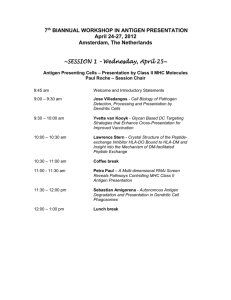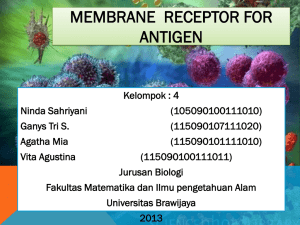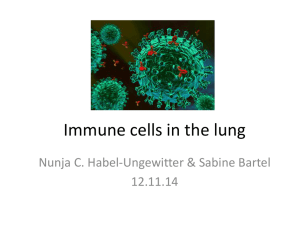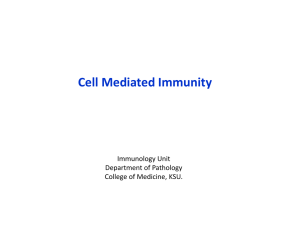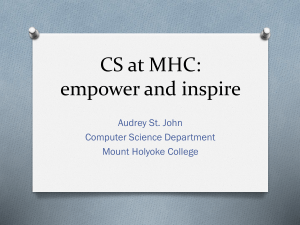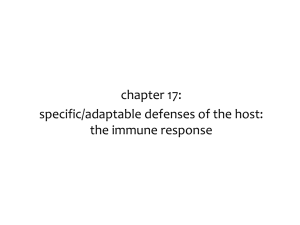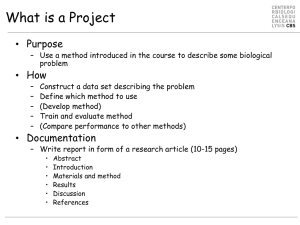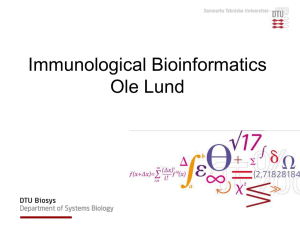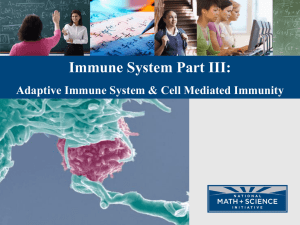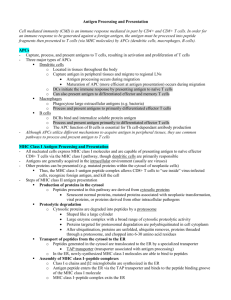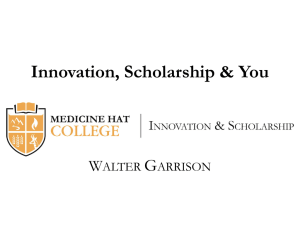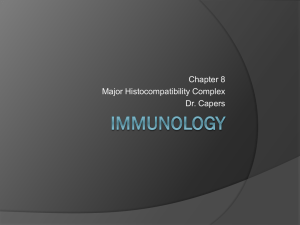PPT 2003
advertisement
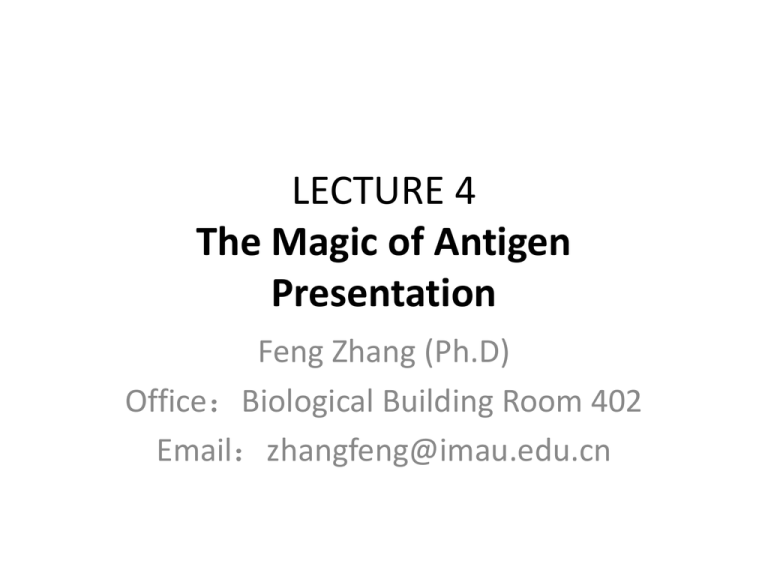
LECTURE 4 The Magic of Antigen Presentation Feng Zhang (Ph.D) Office:Biological Building Room 402 Email:zhangfeng@imau.edu.cn CLASS I MHC MOLECULES CLASS I I MHC MOLECULES ANTIGEN PRESENTATION BY CLASS I MHC MOLECULES • the MHC I billboards advertise a “sampling”of all the proteins that are being made inside a cell. • Almost every cell in the human body expresses class I molecules on its surface, although the number of molecules varies from cell to cell. • Killer T cells (also called cytotoxic lymphocytes or CTLs) inspect the protein fragments displayed by class I MHC molecules. • Consequently, almost every cell is an “open book” that can be checked by CTLs to determine whether it has been invaded by a virus or other parasite and should be destroyed. • Importantly, after they have been on the surface for a short while, the MHC billboards are replaced by new ones – so the class I MHC display is kept current. ANTIGEN PRESENTATION BY CLASS I I MHC MOLECULES ANTIGEN PRESENTING CELLS Activated dendritic cells • Dendritic cells can initiate the immune response by activating virgin T cells. • TLRs ( Toll-like receptors ) recognize general characteristics of classes of invaders – not just a single invader. • The second important characteristic of the patterns which TLRs recognize is that they represent structural features which are so important to the pathogen that they cannot easily be altered by mutation to avoid detection. Traveling dendritic cells • It is its ability to “travel when activated” that makes the dendritic antigen presenting cell so special. • By the time it reaches a lymph node, the mature dendritic cell has everything it needs to activate virgin T cells: high levels of class I and class II MHC molecules loaded with the appropriate peptides, and plenty of B7 proteins. • Dendritic cells take a “snapshot” of what is happening on the “front lines,” and carry this image to a lymph node – the place where virgin T cells congregate. There the traveling dendritic cells activate those virgin T cells whose T cell receptors recognize the invader that is “in the picture.” • Dendritic antigen presenting cells are sentinel cells that “sample” antigens out in the tissues. If there is an invasion, DCs become activated and travel to nearby lymph nodes. There they initiate the adaptive immune response by presenting antigen collected at the battle scene to virgin T cells. • Activated DCs are short-lived, and the rapid turnover of these cells insures that the “pictures” they bring to a lymph node are continuously updated. • The number of dendritic cells dispatched from the tissues and the number of replacement dendritic cells recruited will depend on the severity of the attack. Consequently, the immune system is able to mount a response that is proportional to the danger posed by the invasion. Activated macrophages • Dendritic antigen presenting cells don’t kill, and macrophages don’t travel. • Mature dendritic cells activate virgin T cells, and activated macrophages mainly function to re-stimulate experienced T cells. Activated B cells NON-CLASSICAL MHC MOLECULES AND LIPID PRESENTATION • CD1 family of proteins • The CD1, nonclassical MHC molecules have evolved grooves which are designed to bind lipids. • CD1 presentation of lipids to killer T cells THE LOGIC OF CLASS I MHC PRESENTATION • One reason for class I presentation is to focus the attention of killer T cells on infected cells, not on viruses and other pathogens that are outside our cells in blood and tissues • It would be extremely dangerous to have unpresented antigen signal T cell killing. • Most proteins made in a pathogen-infected cell remain inside the cell, and never make their way to the cell surface. So without class I display, many pathogen infected cells would go undetected. In fact, part of the magic of the class I MHC display is that, in principle, every protein of an invading pathogen can be chopped up and displayed by class I MHC molecules for killer T cells to view. • When a protein is chopped up into short pieces and presented by class I MHC molecules, epitopes cannot be hidden from killer T cells. THE LOGIC OF CLASS I I MHC PRESENTATION • Antigen presenting cells only present antigen efficiently when a battle is going on, and helper T cells are educated not to react to our own proteins. Consequently, both the helper T cell and the antigen presenting cell must “agree” that there has been an invasion before a helper T cell can be activated. By requiring that helper T cells only recognize presented antigen, Mother Nature guarantees that the decision to deploy the deadly adaptive immune system is not made by a single cell. MHC PROTEINS AND ORGAN TRANSPLANTS • “major histocompatibility complex”or MHC • the MHC molecules are responsible for immediate rejection of transplanted organs. • the diversity of MHC molecules, which is so important in protecting us from new invaders, creates a real problem for organ transplantation. SUMMARY THOUGHT QUESTIONS • • • • • • • 1. Mother Nature uses “fail-safe technology” to prevent inappropriate activation of the immune system. Can you give several examples of this strategy? 2. Give several reasons why antigen presentation by class I MHC molecules is important for the function of the adaptive immune system. 3. Why does antigen presentation by class II MHC molecules make good sense? 4. Describe the different roles that activated dendritic cells, activated macrophages, and activated B cells playin the presentation of antigen during the course of an infection. 5. During their lifetimes, dendritic antigen presenting cells can be “samplers,” “travelers,” and “presenters.” Describe what DCs are doing during each of these three stages. 6. Some peptides are presented more efficiently than others. What factors influence the efficiency of presentation by class I and class II MHC molecules? • 1, 造物主利用“自动保险”技术来防止免疫系统的不 恰当激活,你能就此策略举出几个例子吗? • 2, 请就MHCⅠ类分子介导的抗原提呈对获得性没有系 统功能具有重要作用,给出几个解释理由。 • 3, MHCⅡ类分子介导的抗原提呈具有什么重要意义? • 4, 请阐述在感染过程中,活化的树突状细胞、活化的 巨噬细胞以及活化的B细胞分别在抗原提呈中发挥的不 同作用。 • 5, 在其生命周期中,树突状抗原提呈细胞经历了“取 样者(samplers)”、“旅行者(travelers)”、和“提 呈者(presenters)”三个时相,请分别阐述树突状细 胞在各个阶段都有哪些活动表现。 • 6, 与同类分子相比较,某些多肽能更有效地被提呈, 请问影响MHCⅠ类和 Ⅱ类分子提呈效率的因素有哪些?
